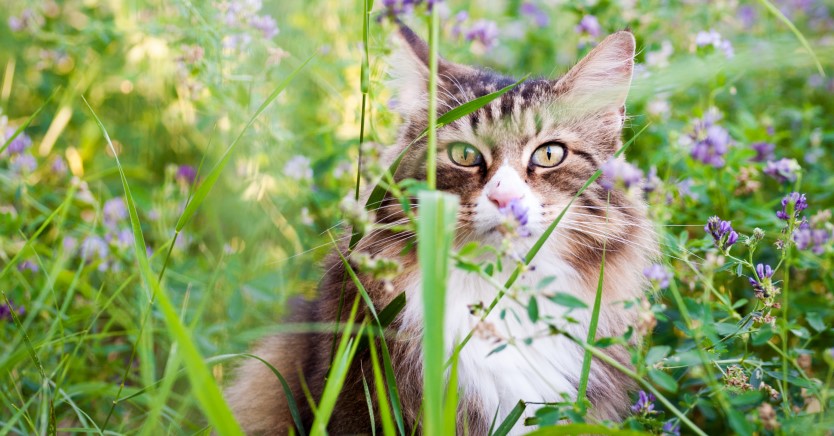Feline Diabetes: Signs, Causes, and Treatment
Take a look at how this condition develops in cats, what to watch for, and how to manage this disease.

Feline diabetes mellitus is one of the most commonly encountered feline endocrine disorders, especially with the ever-growing population of overweight and obese cats in the United States. These two conditions go paw-in-paw, as many cats diagnosed with diabetes tend to be larger than they should. In fact, one of the signs of diabetes is rapid, unexplained weight loss, despite a voracious appetite. If you’re the caretaker of a chubby kitty, your cat may be at risk for developing diabetes. Take a look at how this condition develops in cats, what to watch for, and how to manage this disease.
What is feline diabetes?
Like the human body, the cells in a cat’s body need sugar in the form of glucose for energy. To use glucose for energy, insulin, a hormone produced by the pancreas, is required to “unlock” the cells. Insulin attaches to the cells and sends out signals to absorb glucose to refuel the body’s cells, which lowers the levels of glucose in the blood as the cells metabolize this energy source.
Diabetes mellitus is a condition in which the body cannot properly produce or respond to insulin. If the body cannot create or use insulin properly, elevated levels of glucose appear in the blood, and can also show up in the urine if a high glucose level spills over.
How is feline diabetes different from human or canine diabetes?
Several forms of diabetes exist, and are classified depending on the amount of insulin produced or used by the body. Types of diabetes include:
- Type I (insulin dependent) — Results from autoimmune damage and is associated with a complete lack of insulin
- Type II (non-insulin dependent) — Characterized by abnormal insulin secretion and insulin resistance with an unknown cause
- Type III — Impaired glucose tolerance caused by medication or hormone usage, such as epinephrine, cortisol, glucagon, and growth hormone
- Gestational diabetes
- Congenital diabetes
- Neonatal diabetes
While people can develop many types of diabetes, dogs typically develop Type I and cats have Type II. Cats commonly suffer from Type II diabetes due to genetic predisposition and decreased insulin sensitivity, such as that seen with obesity. Glucose levels are high because the body’s cells do not respond appropriately to insulin, for whatever reason. It is believed that between 0.2% and 1% of the general cat population suffer from diabetes.
What are the signs of feline diabetes?
When a cat suffers from diabetes, the body’s cells are unable to absorb glucose from the blood and become starved for energy. To get the energy it needs, the body turns to other sources, such as breaking down fat and the protein found in muscles to feed glucose-starved cells. As diabetes continues unchecked, the continued breakdown of muscles and fat results in weight loss, despite an increased appetite. Unfortunately, an increased appetite cannot compensate for the body’s inability to use the fuel supplied in the food, and weight loss continues. However, up to 50% of cats may present with a decreased appetite before being diagnosed with diabetes, so appetite alone is not a good indication of disease.
Other signs of diabetes in cats include excessive thirst and urination. The high blood glucose levels can cause the body to excrete glucose in the urine, since urine is produced by the kidneys filtering blood. As the level of glucose in the urine increases, it can pull excessive water into the urine, resulting in increased urination, dehydration, and the desire to drink more.
If your cat develops diabetes, you likely won’t notice immediately. Signs are usually slowly progressive over weeks to months, and can be so subtle, they’re challenging to detect.
What are the risk factors for feline diabetes?
While any cat can develop diabetes—even cats at their ideal weight—there are several factors that may increase your feline friend’s risk for this disease. Risk factors for diabetes in cats include:
- Obesity
- Age
- Physical inactivity
- Neutered male
- Steroid therapy
- Burmese, Siamese, Russian blue, Norwegian Forest Cat, Abyssinian, and Tonkinese breeds
Diabetes is more common in middle-age and older cats, but it can also be seen in young cats. An estimated 1 in 230 cats are affected by diabetes, with overweight, older, neutered male cats most at risk.
How is feline diabetes diagnosed?
Testing for diabetes is relatively simple, provided your cat cooperates with donating blood and urine samples. Diagnosis is achieved by testing glucose concentrations in the blood and urine, along with obtaining a history of clinical signs. Your veterinarian will ask if you’ve noticed an increased thirst and urination, along with weight loss despite an increased appetite.
Although a simple blood test can impart the blood glucose level, it is not always a straightforward result in the veterinary hospital. Many cats become stressed when at the veterinary clinic and display an increase in blood glucose, called stress hyperglycemia. Glucose in the urine can help bolster a diabetes diagnosis, as can an additional blood test that measures fructosamine levels. Fructosamine concentrations are elevated in cats with chronic diabetes, and are not believed to be affected by stress hyperglycemia.
Clinical signs paired with increased blood and urine glucose levels are often clues enough to create a diabetes diagnosis. Once diagnosed, your veterinarian will discuss the treatment plan with you to hopefully help your cat enter remission.
How is feline diabetes treated?
While the thought of giving your cat insulin injections and overhauling their diet can be frightening, most pet owners and cats adapt well to these changes. This two-pronged attack—insulin and diet—offers your cat the best chance at entering remission. With proper management, regular follow-up testing, and communication with your veterinarian, remission rates can be as high as 90%.
The first part of treating feline diabetes is finding the best insulin to control blood glucose levels. Most often, this is an injectable insulin, as it’s the most effective form. In newly diagnosed cats, the insulin glargine is the insulin of choice. Glargine is a long-acting basal insulin, and when used with the appropriate diet, it can lead to remission and discontinuation of insulin in 80% to 90% of patients within the first three to four months of treatment.
The second part of managing feline diabetes, even after potential remission, is the proper diet of a low-carbohydrate, high-protein food. Canned foods are preferable to kibble because they contain lower carbohydrates. However, your veterinarian may recommend a prescription diet to hopefully help your cat reach remission faster.
How can I reduce my cat’s risk of developing diabetes?
To offer your feline friend the best chance at warding off diabetes, or catching it in the earliest stages, be sure to schedule routine wellness exams with your veterinarian. Baseline blood work is often performed, so you can monitor your cat’s glucose level. You can also discover your cat’s ideal body condition score and if any dietary changes are recommended to keep your pet at a healthy weight.
However, if your cat develops diabetes despite your best efforts, keep these important tips in mind:
- Do not change the amount or timing of insulin treatments or diet without consulting your veterinarian, since hypo- or hyperglycemia can lead to serious illness in your cat.
- Watch for signs of hypoglycemia, such as weakness, lack of coordination, seizures, and collapse. If these signs develop after giving your cat insulin, immediately contact your veterinarian for emergency treatment. Keep Karo syrup handy to rub on your cat’s gums to boost blood glucose levels if necessary.
- Unregulated diabetes can result in a life-threatening condition called diabetic ketoacidosis. Signs include increased thirst and urination, lethargy, decreased appetite, and trouble breathing. Contact your veterinarian immediately if you notice any of these signs.
Although a diabetes diagnosis can be scary, and properly managing your cat’s glucose levels can be difficult in the beginning, many cats go on to live long, healthy lives once their glucose levels are regulated. With proper care, you can enjoy many more happy memories with your feline friend.
Ready to start saving money on pet wellness care?
Then take a look at Mint Wellness, the pet wellness plan that provides fast reimbursement on routine pet care. Save on vaccinations, wellness exams, preventatives, dental, and more!
Learn More

